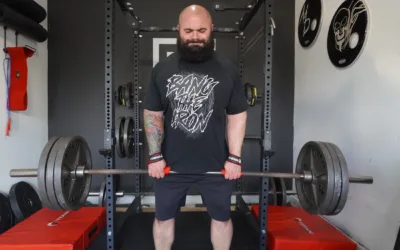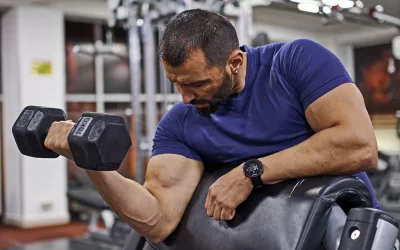The Ultimate Low Back Training Guide: Tips for a Stronger Spine
TOPIC: Recovery | Strength & Conditioning
Low back pain sidelines countless athletes and gym-goers. But here’s the truth: your lower back doesn’t need endless isolation work to stay strong. The real secret? A smart mix of direct and indirect training strategies. This guide breaks it all down, giving you practical methods to keep your lower back pain-free and performance-ready.

Written By
travis hansen
Travis is a Certified Personal Trainer and celebrated author with over 15 years of experience training thousands of members toward their fitness goals.
Insta
Website
Low Back Pain is Not Inevitable
Your lower back powers nearly every movement you make—from lifting weights to getting out of bed. Yet, it’s often ignored until pain strikes. The good news? You can strengthen and protect your lower back with the right approach. This guide simplifies lower back training into two key categories—local and global strategies—giving you actionable tools to stay strong and pain-free. Your best chance at rehab and prehab success is in how you approach these categories.
Local vs. Global Strategies
- Local: Directly targets the lower back through exercises like supermans, child’s pose, and roman chair back extensions.
- Global: Supports lower back health by strengthening surrounding areas, such as glute bridges and scapular exercises.
Pro Tip: Add these drills on rest days or as recovery fillers during rest periods of your working sets for best results.
Let’s break down each category to give you some insight and practical applications to help eliminate future aches or pains.
Local Methods
Flexion Exercises
Flexion-based lower back training once had a bad rap. But there is actually a short list of drills that when done correctly—without added load—can enhance function without compromising movement patterns or risking injury.
- Cat-Camel and Child’s Pose: Floss spinal nerves and gauge your body’s response to flexion.
- Reverse and Stick Crunches: Strengthen the core while minimizing spinal stress.
Key Takeaway: Flexion movements are safe—just avoid loading the spine while it’s flexed.
Lateral Flexion and Rotation Exercises
Lateral stability matters. Many disc herniations involve both posterior and lateral disc shifts, and strengthening this area can prevent painful micromovements.
- Lateral Planks, Chops, and Lifts: Build lateral stability.
- Rotation Control: The lower back isn’t built for extensive rotation. Keep rotational movements minimal.
Focus: Stabilize. Don’t over-rotate.
Hyperextension Awareness
Excessive lower back arching (hyperextension), also known as anterior pelvic tilt, can lead to conditions like spondylolisthesis—high levels of inflammation, overload, and eventual micro–fractures causing major pain.
Common Causes:
- Overextending during squats and deadlifts
- Sleeping on your stomach
- Chronic poor posture
- Tight hip flexors and weak abs
Solution: Maintain a neutral spine. Use this press-up tolerance test to catch hyperextension issues early.

Global Methods
Neck Alignment
Surprise: Your neck affects your back. When it comes to global influence the neck is about as important as anything else. Focus on keeping the cervical spine straight with a proper chin tuck during heavy lifts. There’s plenty of isometric tension and muscular contraction when you lift heavy at the neck and it’s just not smart to train it directly unless you’re a football player or combat athlete.
Shoulder Positioning
Rounded shoulders often lead to lower back strain. Any rounding has to be proportionally countered by your lower back and being that there is little available range of motion or room for error, you’ll likely have problems if you have chronically rounded shoulders.
Tips:
- Prioritize rowing and pulling over pressing.
- Incorporate scapular, rotator cuff, and upper back exercises.
Result: A bulletproof lower back ready for heavy training.
Thoracic Spine (T-Spine) Mobility
A mobile T-spine keeps your lower back from picking up the slack. Your thoracic spine sits above your lower back and like your shoulders, you want to make sure you aren’t too rounded in your middle back. Deficits here will cause subtle and potentially damaging compensation adjustments in your lower back.
- Strengthen the upper back.
- Incorporate these thoracic mobility drills.
Goal: Stay upright and balanced.
Hip Strength & Mobility
Tight or weak hips push stress onto your lower back. Any weakness or lack of motion in your hips will have to be countered and paid for by your lower back. Ensure full mobility in all hip movements: internal/external rotation, flexion, and extension.
Key Exercises:
- Squats and deadlifts
- GHRs and reverse hypers
- Hamstring curls and single-leg deadlift variations
Bottom Line: Strong hips = a resilient lower back.
Knee Function
Healthy knees support strong glutes, taking pressure off your back. Although probably not as important as the hips and upper back, dialing in proper knee function feeds muscle activation through your glutes and takes potential overload off of your lower back in the process.
- Master proper knee extension to prevent ACL injuries and back strain.
- Explore this knee training resource.
Ankle Mobility
Foot and ankle alignment influences posture and back health. Too much flexion of the foot (i.e. swayback posture) or too little will stress your lower back up the chain of your legs, so keep an eye on these.
- Too mobile? Strengthen calves.
- Too stiff? Boost ankle flexibility to prevent compensations in the knees and hips.
Try this foot and ankle mobility drill for smoother movement patterns.
Final Thoughts
By addressing both local and global factors, you can eliminate common triggers of lower back pain and improve performance. The lower back doesn’t work alone—train the entire kinetic chain for strength, stability, and injury resilience.
Find Your Perfect Training Plan
Sometimes all you need to reach your destination on your fitness journey is an expert guide. Look no further, we've got you covered. Browse from thousands of programs for any goal and every type of athlete.
Try any programming subscription FREE for 7 days!
Related Articles
You May Also Like...
Winter Warfare: How to Bulk Up This Season
It’s that time of the year to wreak havoc and prepare for a massive winter bulk! But wait, what is a winter bulk? What does it take, and how do we achieve it? Joseph Lucero (CSCS), owner of Harvesting Strength, is a powerlifter and strongman coach with years of...
How to Do Preacher Curls for Bigger Biceps
Who doesn’t love hitting a good biceps workout and feeling that skin-splitting pump? The preacher curl is a great exercise for bulking up your biceps, but using the EZ bar isn’t the best option for everyone. To build juicy biceps without pissing off your elbow joint,...
Optimize Your Sleep Hygiene for Peak Performance
Every rep, every mile, every drop of sweat, it all counts. But if you’re not prioritizing sleep, you’re sabotaging your own progress. Here’s how to turn your nights into your biggest performance edge.Written ByLily Frei Lily is TrainHeroic’s Marketing Content Creator...
Winter Warfare: How to Bulk Up This Season
It’s that time of the year to wreak havoc and prepare for a massive winter bulk! But wait, what is a winter bulk? What does it take, and how do we achieve it? Joseph Lucero (CSCS), owner of Harvesting Strength, is a powerlifter and strongman coach with years of...
How to Do Preacher Curls for Bigger Biceps
Who doesn’t love hitting a good biceps workout and feeling that skin-splitting pump? The preacher curl is a great exercise for bulking up your biceps, but using the EZ bar isn’t the best option for everyone. To build juicy biceps without pissing off your elbow joint,...

Want more training content?
Subscribe
For Coaches
For Athletes
About
Support
Training Lab
Access the latest articles, reviews, and case studies from the top strength and conditioning minds in the TH Training Lab!
Made with love, sweat, protein isolate and hard work in Denver, CO
© 2024 TrainHeroic, Inc. All rights reserved.





